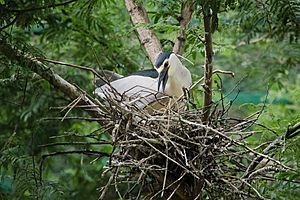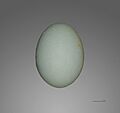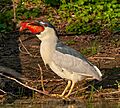Black-crowned night heron facts for kids
Quick facts for kids Black-crowned night heron |
|
|---|---|
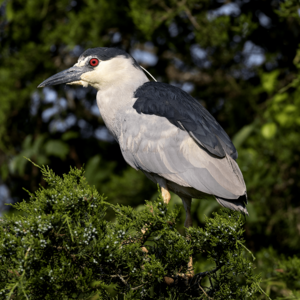 |
|
| At a rookery in Cape May County, New Jersey | |
| Conservation status | |
| Scientific classification | |
| Genus: |
Nycticorax
|
| Species: |
nycticorax
|
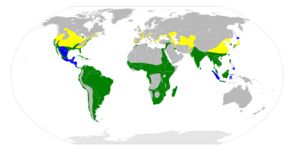 |
|
| Range of N. nycticorax Breeding range Year-round range Wintering range | |
| Synonyms | |
|
Ardea nycticorax Linnaeus, 1758 |
|
The black-crowned night-heron (Nycticorax nycticorax) is a medium-sized bird. It's often just called a night-heron. You can find these birds in many parts of the world. They live in Europe, Asia, and North and South America. In places like Australia, a similar bird called the nankeen night-heron lives instead. Sometimes, these two types of herons even have babies together.
Contents
About Their Name
The black-crowned night-heron got its scientific name from a Swedish scientist named Carl Linnaeus in 1758. He first put it in a group with other herons and egrets. Later, in 1817, it was placed in its own group called Nycticorax.
The name Nycticorax comes from ancient Greek words. Nux or nuktos means "night," and korax means "raven." So, the name means "night raven." People in the past used this word for a bird that was thought to bring bad luck, maybe an owl.
Different Types of Night-Herons
Scientists recognize four main types, or subspecies, of the black-crowned night-heron:
- N. n. nycticorax: Found in Europe, Asia, Africa, the Philippines, and Indonesia.
- N. n. hoactli: Lives in North and South America, from Canada down to Argentina and Chile, and also in Hawaii.
- N. n. obscurus: Found in Chile and southwestern Argentina.
- N. n. falklandicus: Lives in the Falkland Islands.
In the Falkland Islands, people call this bird quark. This name sounds like the noise the bird makes. Many other languages also have names that sound like the bird's call. For example, in Dutch, it's kwak, and in Russian, it's kvakva.
What They Look Like
Adult black-crowned night-herons have a black cap on their head and a black back. The rest of their body is white or grey. They have bright red eyes and short yellow legs. Their wings are pale grey, and their undersides are white.
When they want to show off, especially during courtship, they can raise two or three long white feathers from the back of their head. Males and females look similar, but males are usually a little bigger.
Night-herons don't look like typical herons. They are more chunky, with shorter beaks, legs, and necks than their cousins, like egrets. When they are resting, they often look a bit hunched over. But when they are hunting, they stretch out their necks and look more like other wading birds.
Young Night-Herons
Young night-herons look different. They have dull grey-brown feathers on their heads, wings, and backs. They also have many pale spots. Their undersides are lighter and have brown streaks. Young birds have orange eyes and duller yellowish-green legs.
These birds are very noisy, especially where they nest. Their calls often sound like "quok" or "woc."
Size of Night-Herons
Here are some average measurements for black-crowned night-herons:
- Length: About 58 to 66 centimeters (22.8 to 26 inches)
- Weight: Around 725 to 1015 grams (25.6 to 35.8 ounces)
- Wingspan: About 115 to 118 centimeters (45.3 to 46.5 inches)
Where They Live
Black-crowned night-herons live in wetlands, which are areas with lots of water like marshes and swamps. They can be found in both fresh and salt water.
They build their nests in colonies, which are large groups of birds nesting together. They make platforms of sticks in trees or on the ground in safe places like islands. A female heron usually lays three to eight eggs.
Migration and Homes
Some night-herons are migratory. This means they fly to warmer places for winter if they live in very cold areas. For example, herons from North America fly south to Mexico, the southern United States, Central America, and the West Indies for winter. Birds from Europe and Asia fly to tropical Africa and southern Asia.
However, in many places, they stay all year round, even in colder regions like Patagonia.
A group of these herons has spent their summers at the National Zoo in Washington, D.C. for over a hundred years. They also live all year around the San Francisco Bay, with a very large nesting area in Oakland. Because they are always present in Oakland, especially around Lake Merritt, and are tough birds that adapt to city life, they have been named Oakland's official city bird!
How They Behave
These birds are mostly active at night or early in the morning. They stand very still at the edge of the water, waiting to catch their food by surprise.
What They Eat
Their diet is quite varied! They mainly eat small fish, but they also enjoy leeches, earthworms, mussels, squid, and crustaceans like crayfish. They also eat frogs, other amphibians, and different kinds of insects. Sometimes, they catch lizards, snakes, small mammals (like rodents), and even small birds or eggs. They might also eat dead animals or even garbage near landfills.
Interestingly, black-crowned night-herons are one of the few bird species known to use "bait fishing." This means they will drop something edible or not edible into the water to attract or distract fish. This is a rare example of a bird using a simple tool!
During the day, these herons usually rest quietly in trees or bushes.
Gallery



